Do you want to learn how to cook easy and healthy East Asian recipes? It all starts with Healthy World’s Cuisine’s printable shopping list of Essential Asian Pantry Staples. Most of these basic ingredients can be found right at your local grocery store. In addition, we will be sharing some of our easy substitutions tips so you can start making some of your favorite Chinese, Thai, Japanese, Korean or Vietnamese recipes straight away.
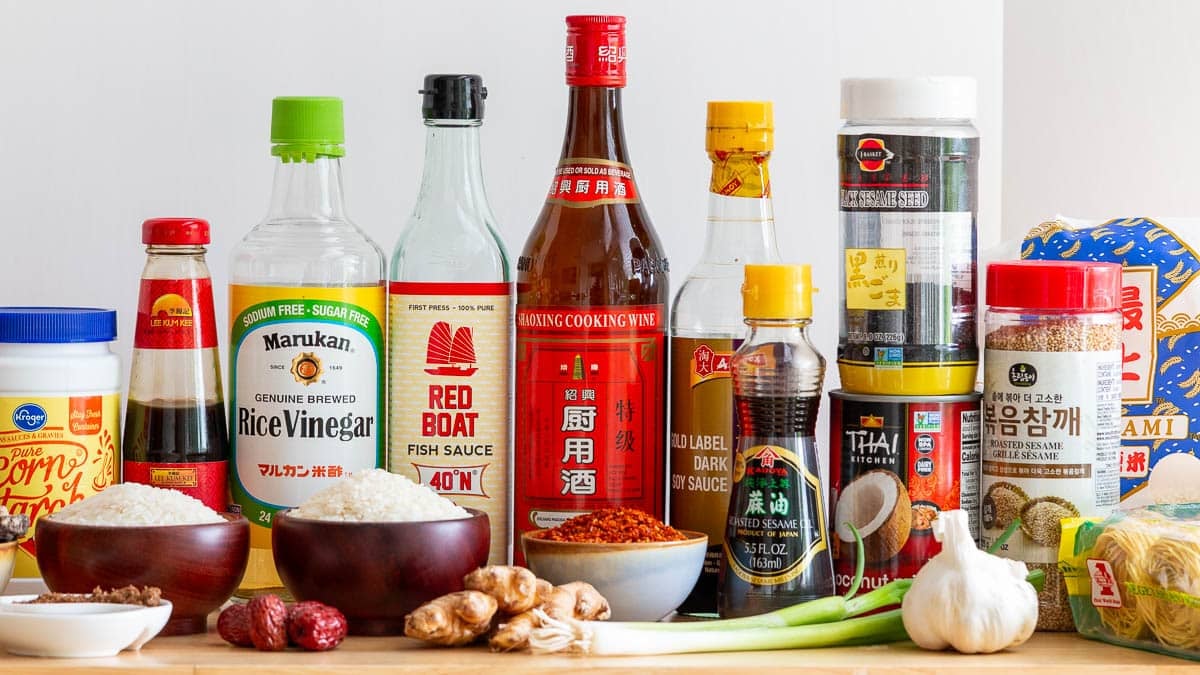
We cook healthy recipes from all over the world. But hands down our favorite easy recipes are cooking healthy East Asian dishes with bold umami flavors. Whether we are whipping up a quick and easy Asian steamed fish, bay scallops stir fry with spring veggies or Thai Style ground beef bowls, these basic pantry supplies are essential.
Jump to:
- Getting Organized
- 13 Essential Asian Pantry Staples for the Everyday Cook
- 1. Rice
- 2. Noodles
- 3. Soy Sauce
- 4. Fish Sauce
- 5. Sesame Oil
- 6. Cooking Wine
- 7. Rice Vinegar
- 8. Neutral Oil
- 9. Aromatics
- 10. Sriracha or Chili Sauce
- 11. Sweeteners
- 12. Cornstarch or Potato Starch
- 13. Oyster Sauce
- Nice to Have Kitchen Staples for Asian Cooking
- 1. White Pepper
- 2. Sesame Seeds
- 3. Coconut Milk
- 4. Dried Mushrooms
- 5. Nori – Gim – Laver - Dried Seaweed
- 6. Miso Paste
- 7. Tofu
- 8. Hoisin Sauce
- Time to Stock Up!
- East Asian Recipes
- Essential Asian Pantry Staples: Your Guide to Cooking
Getting Organized
It all started with the spring cleaning of the kitchen and organizing the pantry! Oh my, as you know that is a big job! After watching several videos with Marie Kondo (sweet Japanese lady known for her tidying up methods), we got the organizing bug.
We sorted, organized, analyzed the basic requirements from all the hundreds of sauces, spices and aromatics, created this guide for you and a helpful video. In this ultimate guide of essential Asian pantry staples, you will learn more about each ingredient, where to buy it, how to store it and a delicious recipe to try it in.
This is not an exhaustive list of every Asian ingredient known to man. Instead, this is a concise list includes of our everyday supplies OR common ingredients that are used in more than one Asian Cuisine. For very specific Thai, Chinese, Japanese and Korean ingredients, we will have special edition ingredient pantry posts for each of these special cuisines. So, let’s get started!
Please note: This post in not sponsored in any way. Theses are just some of the regular items we currently have in our pantry.
13 Essential Asian Pantry Staples for the Everyday Cook
Are you new to East Asian cooking or are you looking to expand your repertoire of recipes? With these 13 cooking essentials, you are going to take your recipes to the next level. There are 5 flavors in Asian cooking: savory, sweet, spicy, sour, and bitter. When you blend them together – you get one delicious bite. Balancing the aromatics, spices, sauces, and ingredients together takes a little practice but we are here to help. Let’s make your taste buds sing with these Asian pantry basics.
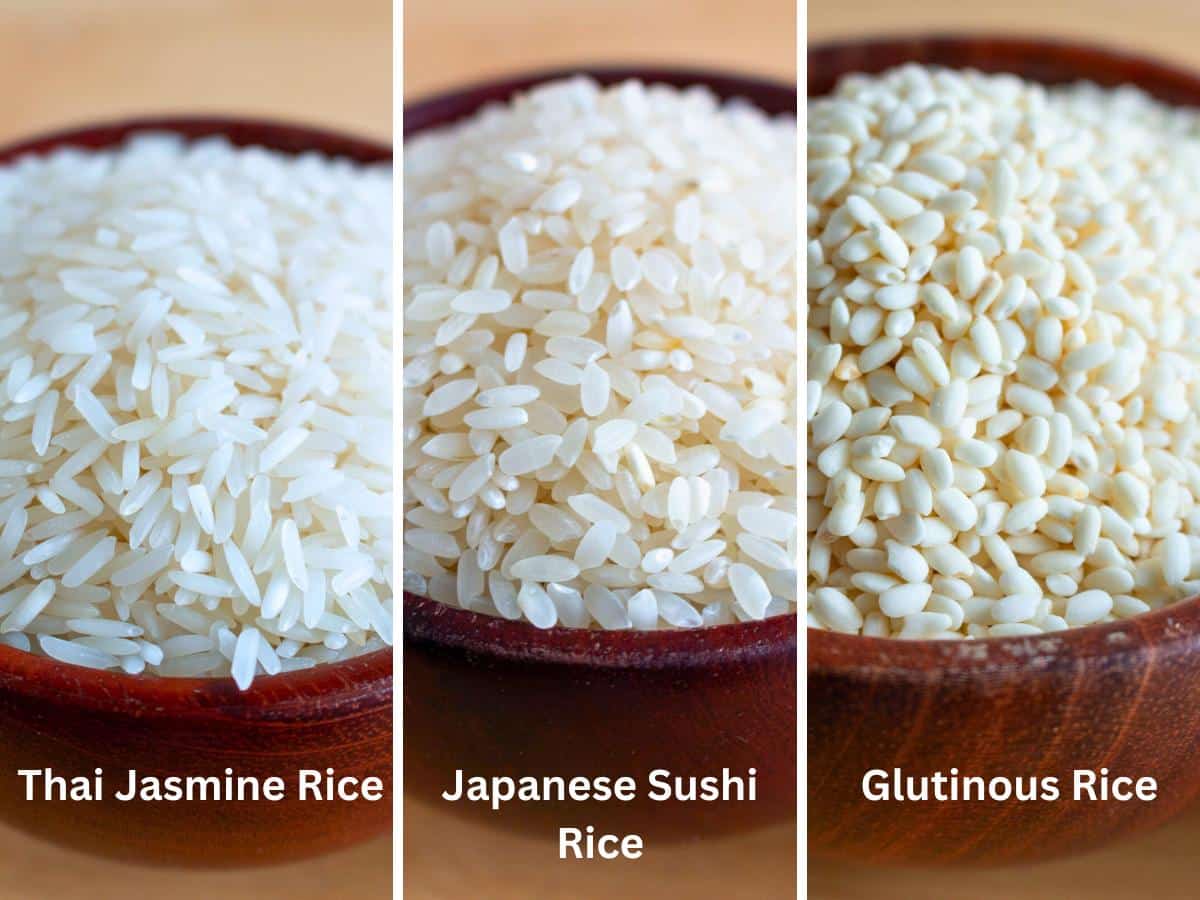
1. Rice
Naturally gluten-free, inexpensive, and filling, rice is one of the main carbohydrates of choice in East Asian cuisine. It’s a delicious way to lop up stir fry sauces, a hearty addition to congee soups, or even a fun addition to desserts like mango sticky rice. The rice varieties of East Asian cuisine include Jasmine rice, regular long grained rice, Sushi rice and glutinous rice. Going low carb? Try cauliflower rice or skip it all together and add more veggies.
How to Store Rice Please keep uncooked rice in an airtight container in a cool, dry place up to 4 to 5 years. Please note that Thai Jasmine rice may lose some of its aroma with extended shelf life. Cooked and cooled rice can be stored in the refrigerator for up to 3-4 days or frozen up to 6 months.
Fragrant Thai Jasmine Rice
This is our favorite long grained rice. It has a jasmine flower or pandan leaf aroma due to a compound occurring naturally in the rice and is less sticky making it perfect for Hong Kong Fried Rice. We always look for the Thai Hom Mali labeling which assures the highest export quality of premium Thai grown jasmine rice. You can purchase Thai Jasmine rice in your regular grocery store in the Asian Food section, online or in an Asian food market.
Regular Long Grain Rice
Your standard run of the mill long grain rice is grown around the world. It does not have the special Jasmine aroma but it can be found easily in a regular grocery store.
Japanese Short Grained Rice
It's also called sushi rice. This type of rice is stickier making it the perfect choice for crab sushi bake, tuna mayo rice balls or Korean rice balls. If your local grocery store has a VERY robust Asian food section, you may be able to find it there. Look for our favorite brands like Nishiki or Koshihikari or you may need to purchase traditional Japanese sushi rice at a dedicated Asian food market or online.
Glutinous Rice
Have you ever tried this type of rice also called sticky rice or sweet rice? It does not contain gluten but the texture is glue-like but chewy and completely addictive. This is not an essential ingredient per say but it is used in many different East Asian cuisines. A must have ingredient if you enjoy mango sticky rice.
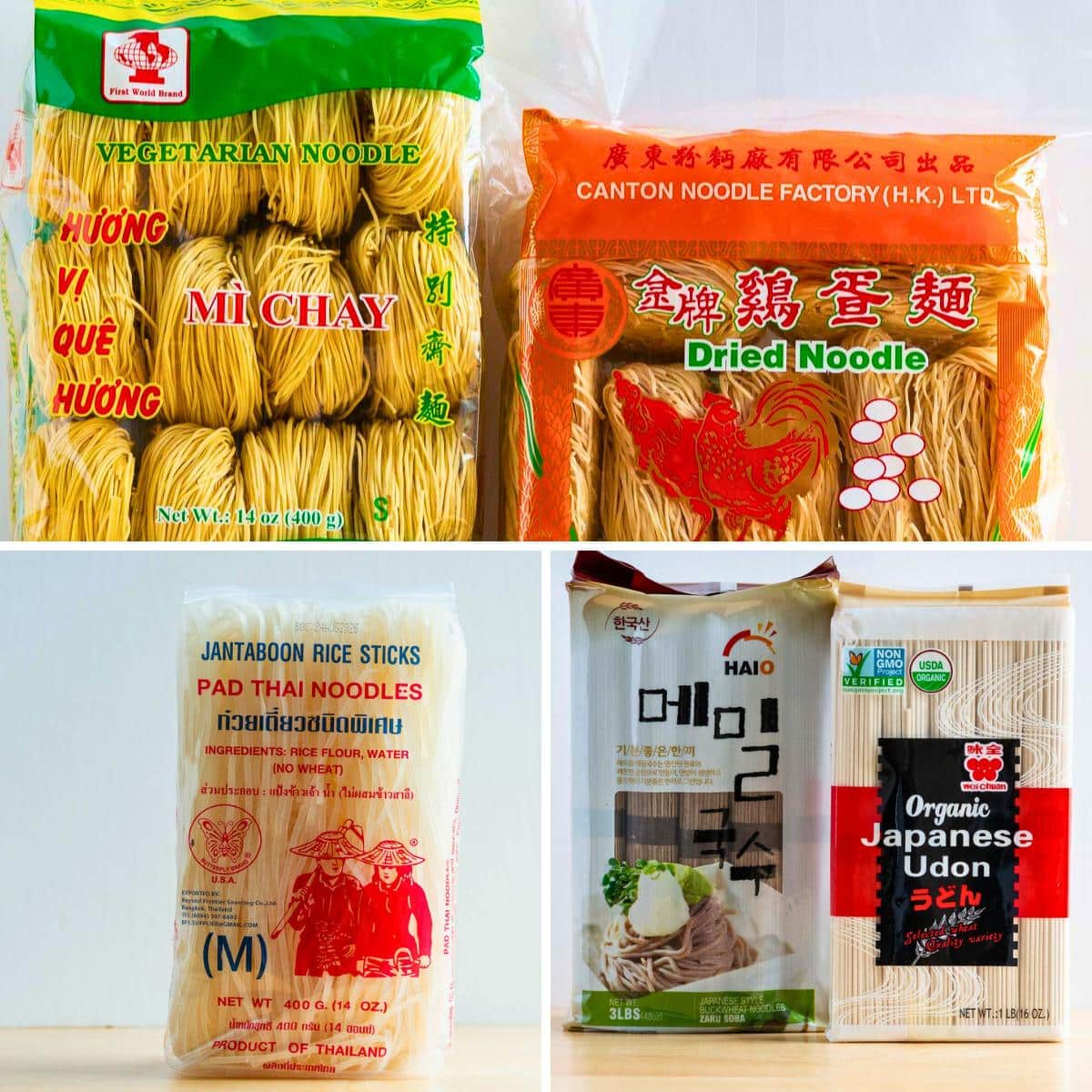
2. Noodles
It’s a noodle lover’s paradise out there with so many choices. From fun textured glass noodles in our spicy tomato soup to soba noodle salad, there is something for everyone. Some noodles can be found in the Asian section of your grocery store, online or Asian Market.
Don’t stress it if you cannot find what you need. You can substitute regular spaghetti or angel hair pasta and still make something extra delicious. Listed below are some of our favorites - choose the ones you like best.
How to Store Noodles: Fresh uncooked noodles are best used in a couple of days or for extended storage in the freezer for 3 months. Dried uncooked noodles can last a long time, even years if stored in a cool and dry environment.
Rice noodles
Rice noodles come in many sizes from super thin to super thick. We use a medium size noodle for Pad Thai and vermicelli sized noodles in our golden spiced noodle soup. The good news is that you can usually find these in the regular grocery store in the Asian food section and many are gluten free.
Lo Mein or Chow Mein Noodles
These noodles are typically made with wheat flour and eggs. Lo Mein are usually fresh noodles sold in the refrigerated section of an Asian grocery store. However, chow mein noodles can be dried. An easy substitution is Italian angel hair pasta.
Soba Noodles
Soba are made with buckwheat flour and sometimes wheat. If you are celiac, be sure to read the ingredients label. They can be enjoyed hot or cold like in our soba noodle salad with yuzu dressing. You can find Japanese soba noodles fresh or dried in Asian markets or online.
Udon Noodles
Udon is a delicious addition to Japanese and Korean recipes and are made with wheat flour, water, and salt. They are chewy, thick, and fun to eat in our tempura udon soup and Sukiyaki beef udon. You can find fresh or frozen udon in an Asian Market. Sometimes, you can find the dried version in the regular grocery store in the Asian section.
Rice Vermicelli
Super fun to eat, these extra thin noodles are made with rice flour and water. We soak them in hot water to cook and rinse in cool water to stop the cooking process. Rice noodles turn opaque when cooked. They are the perfect slurping noodle in our Vietnamese shrimp vermicelli salad. You can find rice vermicelli noodles online or in Asian market dried.
Glass Noodles
Sometimes glass noodles are referred to as cellophane noodles, fensi, bean thread noodles or Chinese vermicelli if made with mung bean starch. In addition, they can be made with sweet potato noodles like in our camote bihon dish from the Philippines. They have a very fun springy texture and turn translucent when cooked. Glass noodles can be found dried at the Asian market or online.
Others Noodles like ramen, homemade wontons for soup and many others are a delicious addition to the pantry.
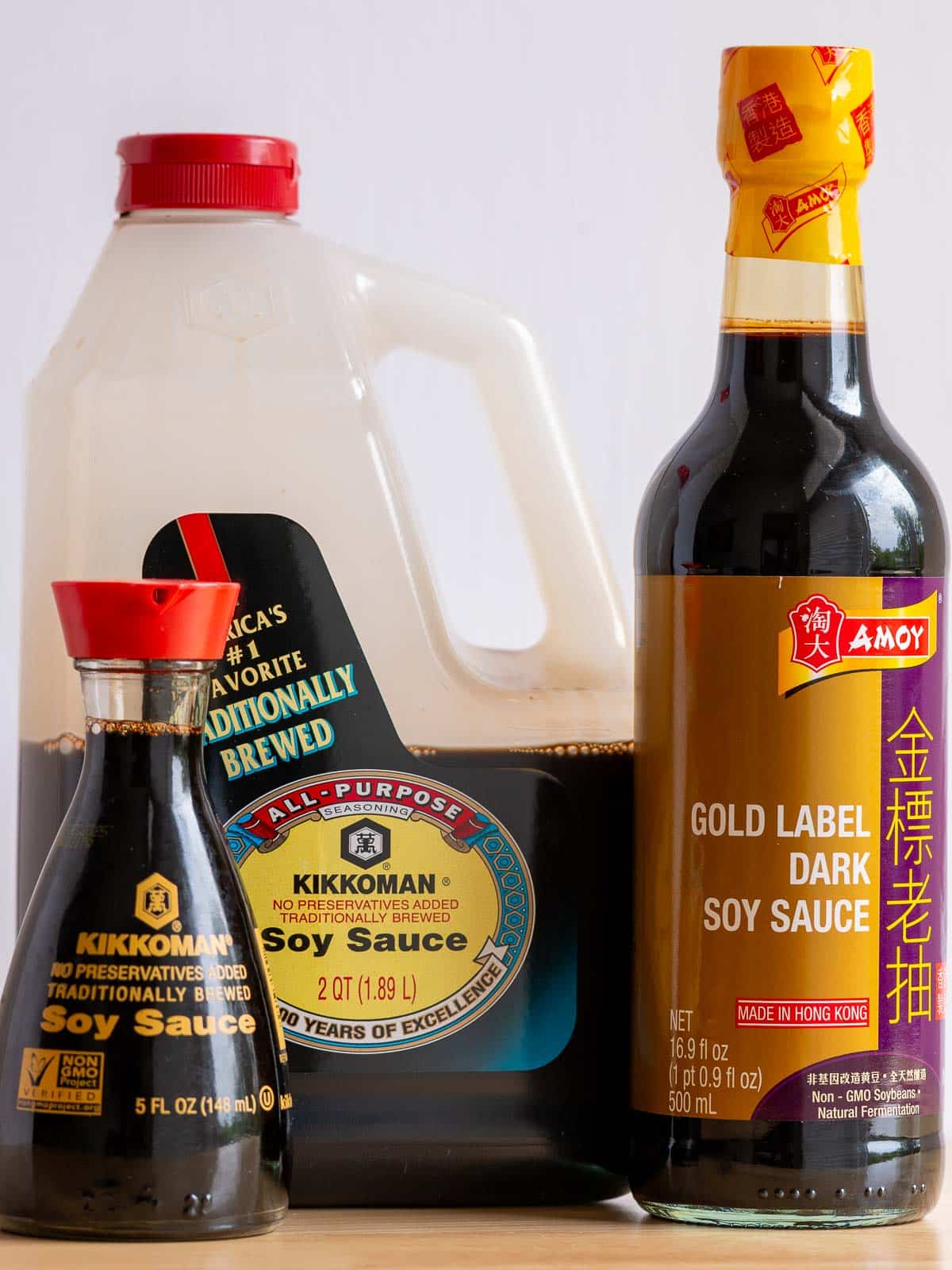
3. Soy Sauce
When you think about Asian cooking, what’s the first condiment you come up? We bet you guessed soy sauce, right! It’s a wildly popular condiment used in Asian cuisine used to add a savory umami flavoring to dishes. We can’t picture our pork and bamboo stir fry or dipping sauces without it.
Traditional soy sauce is made with four basic ingredients: soybeans, wheat, salt, and water. After the tedious process of fermenting, mixing, aging, pressing, heating, and bottling, its ready to add a pop of delicious flavor to your dishes.
How to Store Soy Sauce: This Asian pantry ingredient can be stored at room temperature away from light and in a cool place, even after opened. If you do not use this condiment frequently, you can store in the refrigerator to maintain its flavor and quality. The four main types of soy sauce and substitutions are listed below.
Light Soy Sauce
Traditional or light soy sauce is the ingredient to be used when a recipe calls for soy sauce but does not specify which type. It is saltier, thinner, and lighter in color compared to dark or sweet soy sauce. You can find this at pretty much any grocery store in the US or in Asia.
Dark Soy Sauce
Dark soy sauce is thicker, darker, a bit richer but less salty in flavor compared to light soy sauce. Is it essential? Our answer is no. However, because dark soy sauce is used in more than one Asian cuisine, it is listed here. It is usually used in dishes like tea smoked chicken or noodle dishes to add color. Unfortunately, this ingredient is usually only available at an Asian market or online.
Sweet Soy Sauce (Kecap Manis)
If you want to cook a lot of Indonesian cuisine, sweet soy sauce would be a nice addition to your kitchen staples. It is much thicker than light or dark soy sauce and its sweet and savory. This item will need to be purchased at an Asian grocery store or online.
Tamari Sauce
This type of Japanese type of soy sauce that is made usually without wheat. Tamari makes it a good gluten free alternative. However, please note that we find that it is slightly stronger and saltier compared to light soy sauce.
Coconut Aminos
A good gluten free soy sauce alternative is coconut aminos. This sauce made from the sap of coconut blossoms and salt. We think it tastes less salty compared to Tamari sauce.
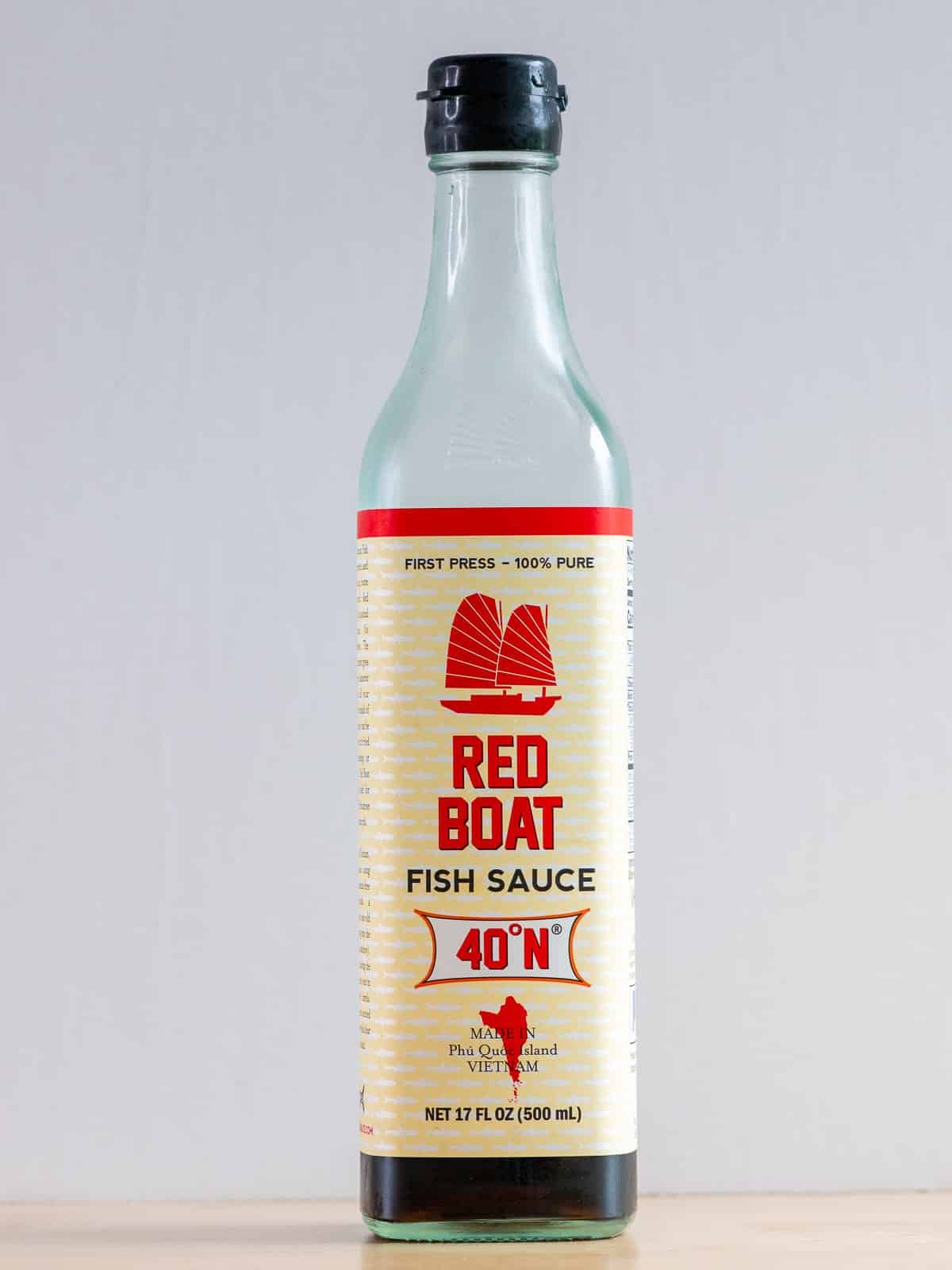
4. Fish Sauce
If you have ever smelled fish sauce, you know exactly the aroma we are talking about. Yep! Its stinky, funky and is a savory flavor bomb for many Thai, Vietnamese, Cambodian, Laotian and Pilipino cuisines. It’s made with fermented fish and salt.
Packed with savory, funky and umami flavors that make recipes like prik nam pla and Thai turkey meatballs in a coconut curry sauce pop! You can usually find fish sauce in the US in the regular grocery store in the Asian food section. A delicious gluten free option brand that we use all the time is Red Boat.
How to Store Fish Sauce: It is shelf stable in a cool dark place with the lid on tight. If you do not use fish sauce frequently, we recommend refrigeration based on the expiration of the bottle.
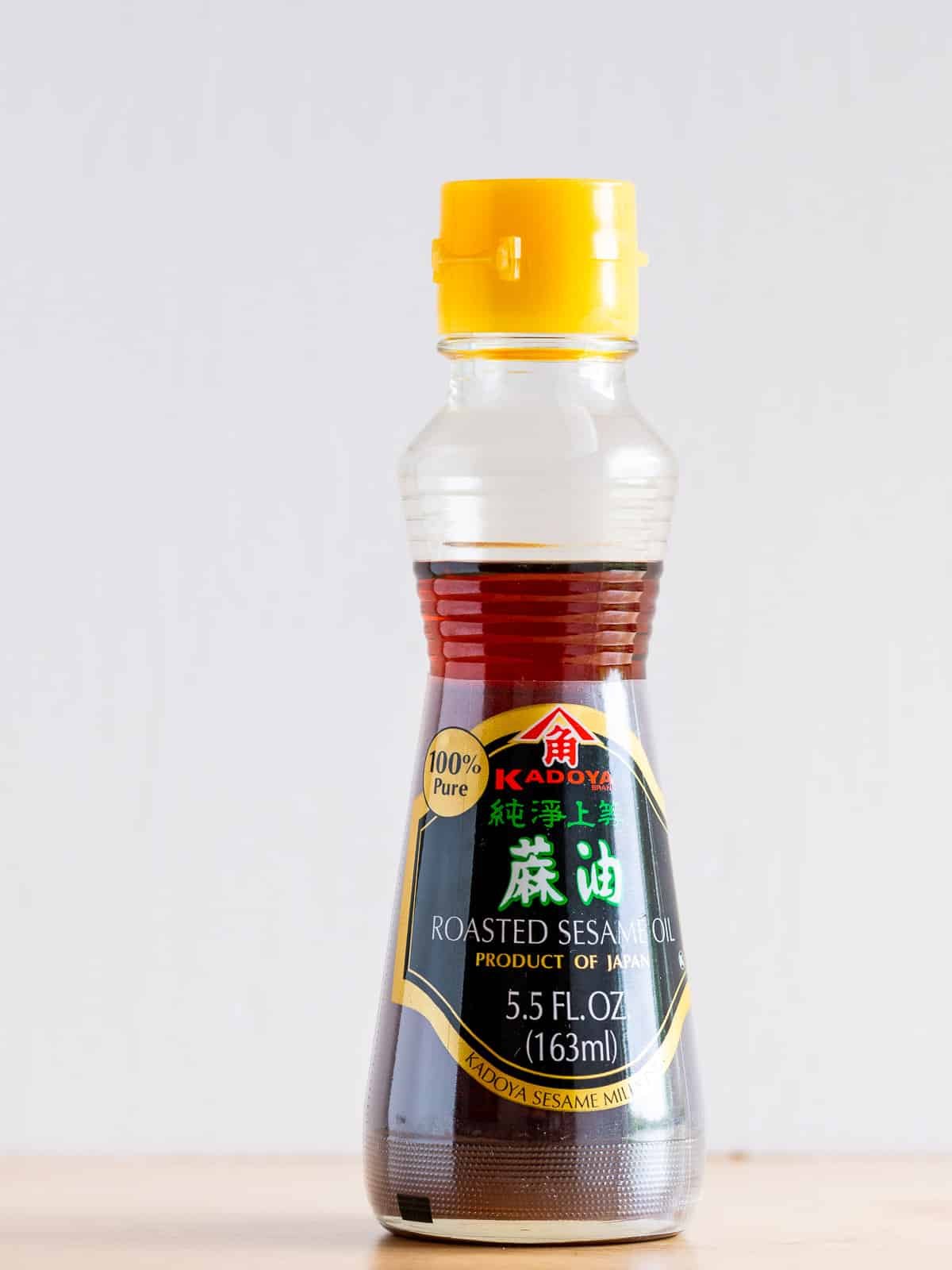
5. Sesame Oil
It’s nutty, aromatic, and so delicious! It's one of our favorite essential Asian pantry staples. Sesame oil is made by extracting the oil from sesame seeds. There are 3 types.
- Light Raw Sesame Seed Oil is the cheapest option but not very nutty because it is not roasted. It’s usually used for light stir frying or cooking.
- Premium Roasted Sesame Oil is made from roasted white sesame seeds. Its dark amber color and the ingredient you need for an East Asian pantry. It is used as a finishing oil and is deeply nutty in everything from an quick and easy stir fried romaine lettuce to orange glazed salmon bites. It’s a pretty common ingredient you can find in the US grocery store down the international food isle.
- Black Sesame Seed Oil is made from black sesame seeds and is rich and nutty. This specialty ingredient is available at an Asian market or online.
How to Store Sesame Oil: Please store in a cool and dark location. As sesame seeds can go rancid, we recommend using it within 6 months.
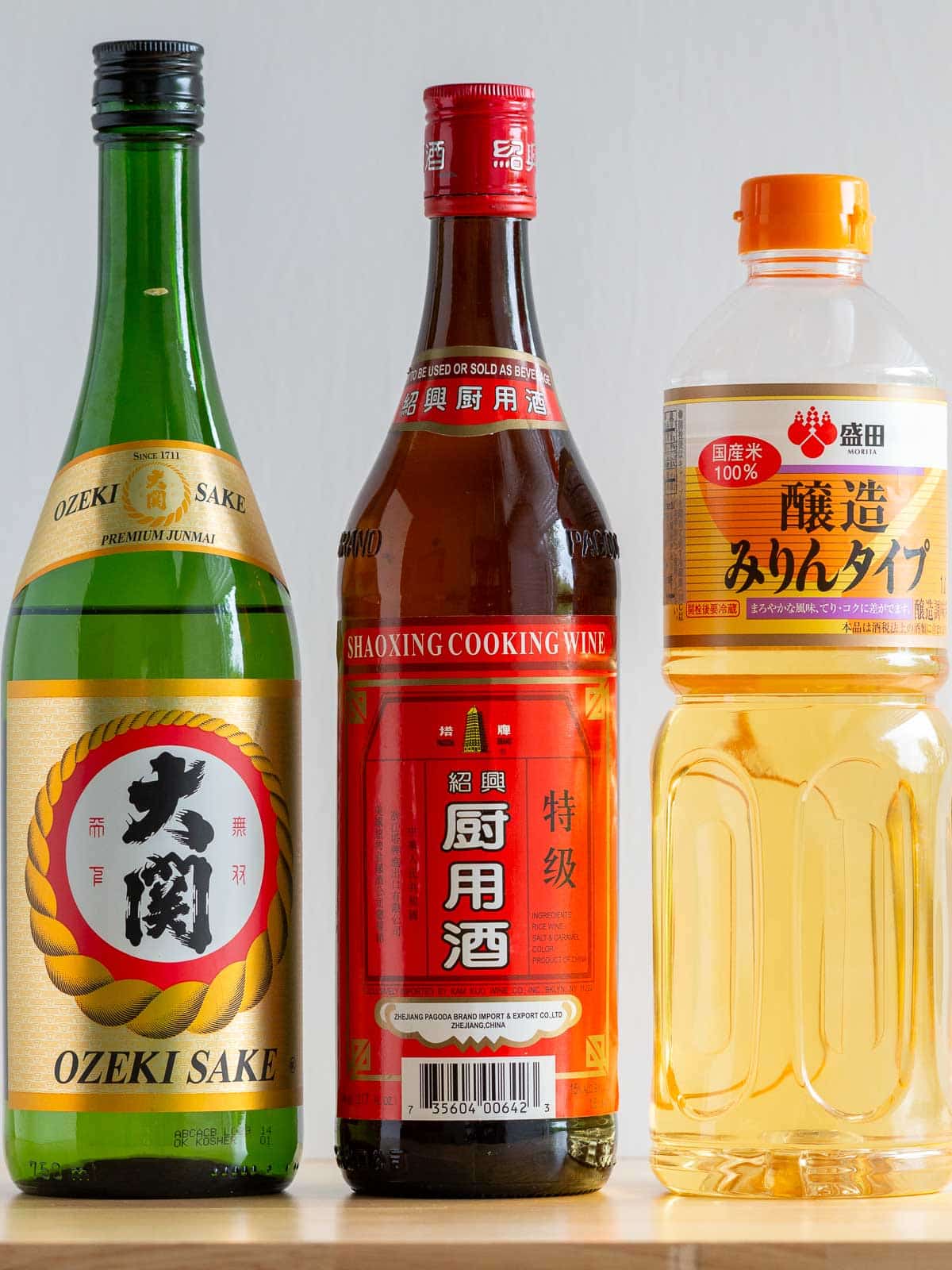
6. Cooking Wine
Rice wine is an important Asian pantry essential, so stock up. It’s used in marinades especially to get rid of gamey or fish aromas before cooking. Cooking wine helps tenderize meats, flavor soups and perk up stir fry sauces like our hot and spicy mandarin orange chicken. There are many different Asian cooking wines to choose from. If you cannot find rice wine, then just substitute it with cooking sherry.
How to Store Cooking Wine: This product can be stored at room temperature in a cool, dry place away from direct sunlight. After you open it, try to use it within 6 months or store in the refrigerator for longer shelf life. If it starts smelling like vinegar, it has gone bad.
Shaoxing (Chinese Rice Wine)
We use Shaoxing wine for most of our Cantonese recipes. If you live in China and purchase Shaoxing wines from the Zhejiang province, you can get the “real deal” without any added salt. You could pour yourself a glass and drink it.
Unfortunately, if you purchase Shaoxing wine anywhere else in the world they add salt for tax purposes, and to sell it as a cooking ingredient instead of alcohol. Don’t be pouring yourself a glass to drink unless you like a salty wine!
Japanese and Korean Recipe Cooking Wines
We prefer to use mirin, ashi-mirin, or even sake. These are Japanese rice wines and all three are a little different flavor profile.
- Mirin (Hon-Mirin) is a sweet Japanese rice wine. It is fermented the natural way and has a natural sweetness. It has a higher alcohol concentration, is more expensive and is available at an Asian Market, so it is harder to find.
- Ashi-Mirin is also a sweet Japanese rice wine. However, instead of the natural fermentation process they add sweeteners, salt, and other flavors to boost its flavor. Some robust US grocery stores have ashi-mirin down the international isle.
- Sake is a rice wine meant for drinking. The alcohol is not sweet like mirin but sometimes we use this if we are having a little whilst cooking.
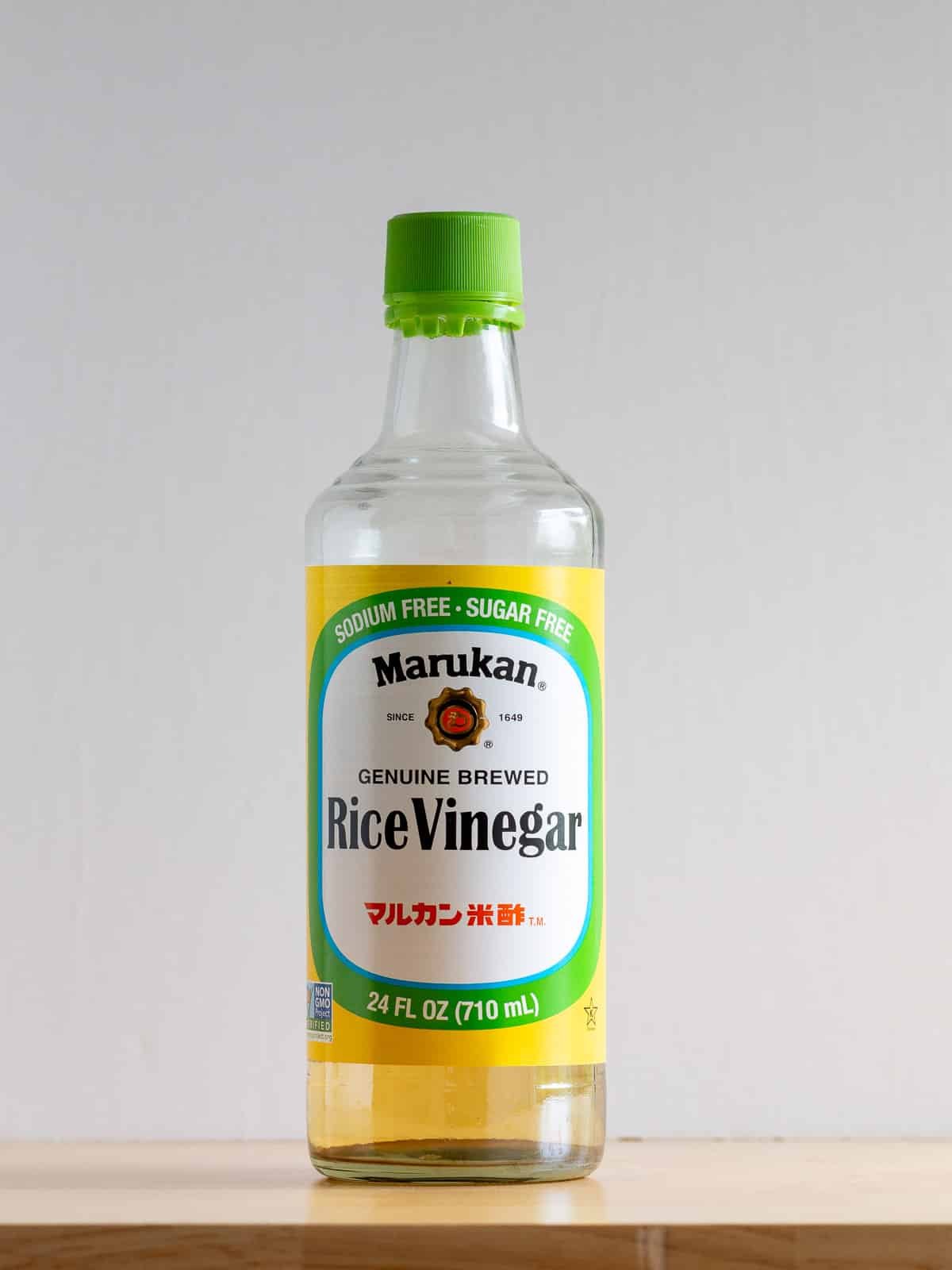
7. Rice Vinegar
From the zippy sauce on General Tso’s chicken wings to a tangy dressing for a soba noodle salad, rice vinegar is good shelf stable ingredient to have in an Asian pantry. You can find it at any grocery store. If not, feel free to substitute with apple cider vinegar or even plain white vinegar. When you are looking for rice vinegar at the grocery store, you are looking for plain rice vinegar and not sushi (seasoned) rice vinegar that has sugar and salt added.
How to Store Rice Vinegar: It can be stored at room temperature in a cool, dry place away from direct sunlight for many years.
8. Neutral Oil
We are going to go ahead and let you decide which type of neutral oil you wish to use. For stir frying, it is best to use an oil that has a high smoke point. In China, they use peanut oil but with so many nut allergies we stay away from this option. At home, we use avocado oil or in a pinch even olive oil. Olive oil does not have a high smoke point but it’s a healthier option.
How to Store Oil: It can be stored at room temperature in a cool, dry place away from direct sunlight. It can last 6 to 8 months.
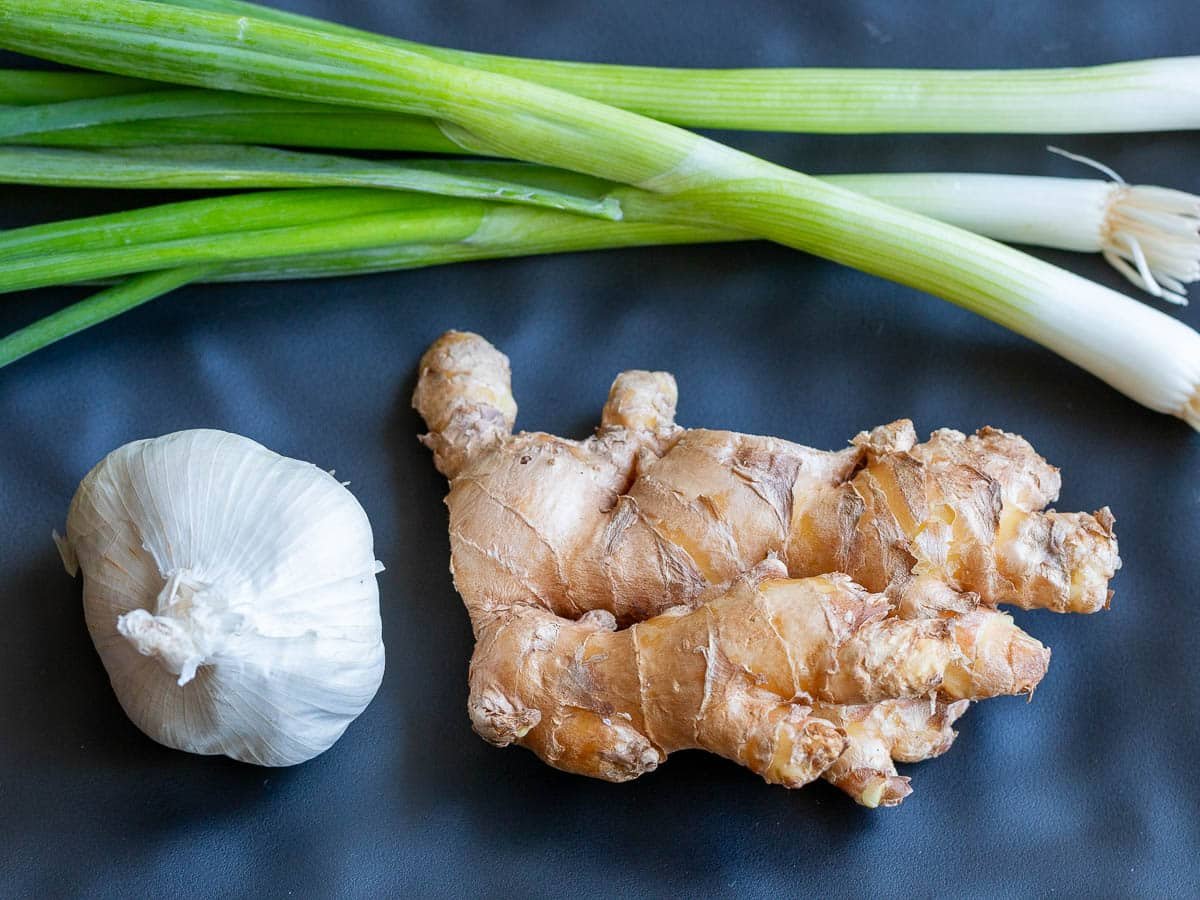
9. Aromatics
Garlic, green onions, and ginger are the trio of aromatics commonly used in our Asian kitchen. You may also like to add coriander (cilantro), fresh chilis to the list, or check post on essential Thai herbs and spices if you love Thai recipes. Fresh is best especially when making dishes like steamed fish. However, in a pinch try aromatic pastes or even substitute dried herbs and spices.
How to Store Aromatics: Fresh green onions, ginger, chilis and coriander are best stored in the refrigerator. To keep cilantro fresh a longer time. Place the ends in a glass of water and cover loosely with a plastic bag. Change the water daily. However, garlic is best stored at room temperature.
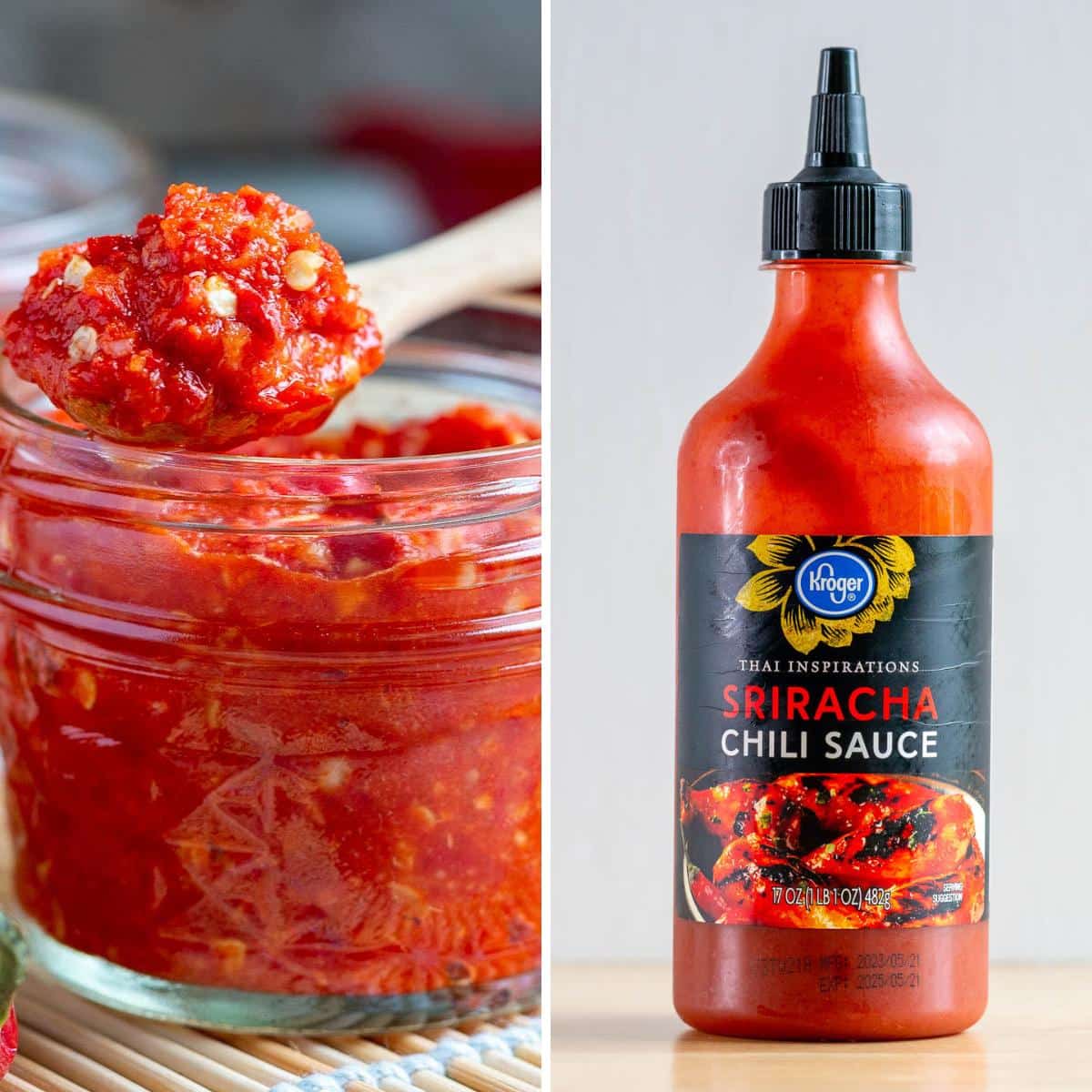
10. Sriracha or Chili Sauce
Have you tried our recipe for Asian Chili Garlic Sauce? A little something spicy along with savory, sweet and sour is what makes Asian recipes so addictive. It is like a party in your mouth. If you crave something spicy, but are short on time, Sriracha sauce is easily assessable at most regular grocery stores down the international isle. Mix a little Sriracha sauce in some Kewpie mayo with lime for a delicious topping to a Vietnamese crab pizza.
How to Store Sriracha Sauce: Once opened, store in the refrigerator until the best due date. Some say it can last up to 3 years, but we use up ours way too fast to test this theory.
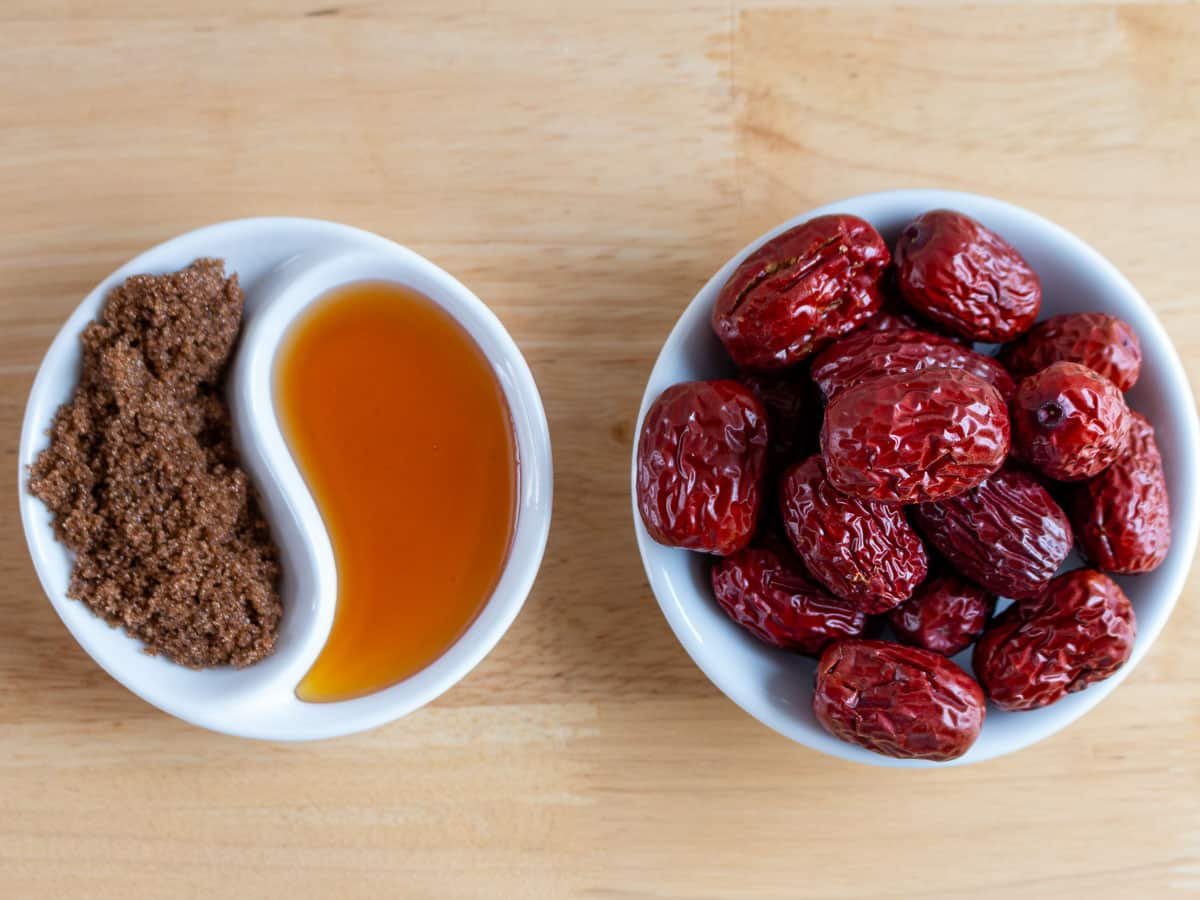
11. Sweeteners
We prefer using natural sweeteners like raw organic honey or Chinese red dates (jujubes). You won’t be able to stop at just one Chinese tea smoked chicken leg because that sticky honey soy glaze has it all going on. We have also been known to use Chinese red dates in stir fries like in our oyster sauce chicken, Instant Pot Chicken Congee and in desserts like out steamed gingerbread.
Chinese red dates are sweet and packed with iron. However, you can substitute brown sugar, rock or granulated sugar, or a sugar substitute of choice in many of our Asian recipes.
How to Store Sweeteners: Store honey and sugars at room temperature in a cool location, in a sealed container away from the sunlight. Chinese red dates can last up to a year in the pantry but make sure they are sealed tight, so they don’t dry out. They can also be refrigerated or frozen for longer storage.
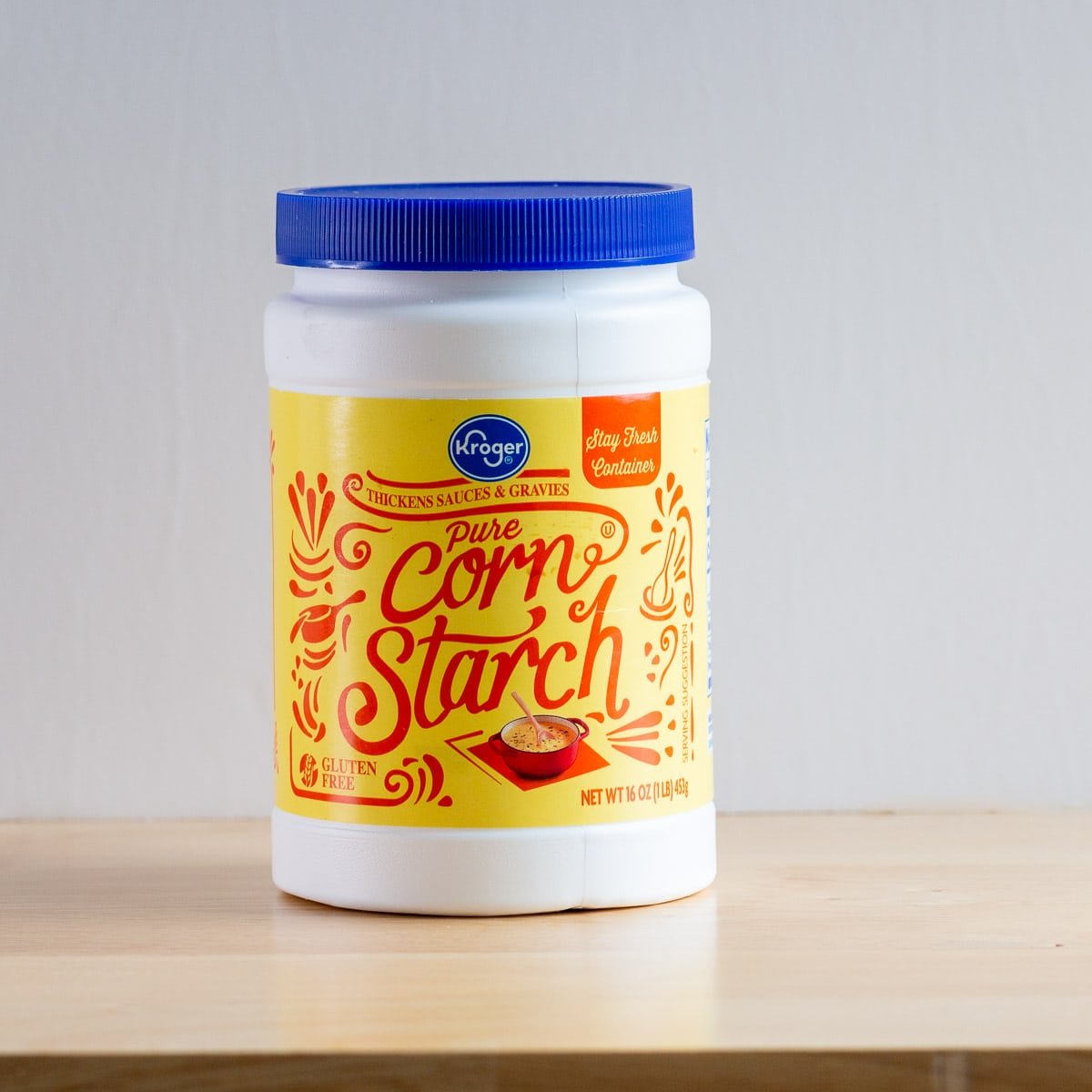
12. Cornstarch or Potato Starch
We bet you already have this staple in your pantry! Cornstarch or potato starch is essential to thicken Asian sauces and to velvet proteins. For example, our spicy lotus root stir fry uses a cornstarch slurry to thicken the sauce. Velveting meats and other proteins with cornstarch or potato starch coats the exterior to seal in the juices during the cooking process. Learn how to velvet chicken and other proteins in our recipe post for Mandarin orange chicken. You can find cornstarch and even gluten-free versions at any local grocery store.
How to Store Cornstarch or Potato Starch: These ingredients are shelf stable and can be stored at room temperature in a sealed container away from heat and moisture. Check the expiration date but this stuff lasts a very long time.
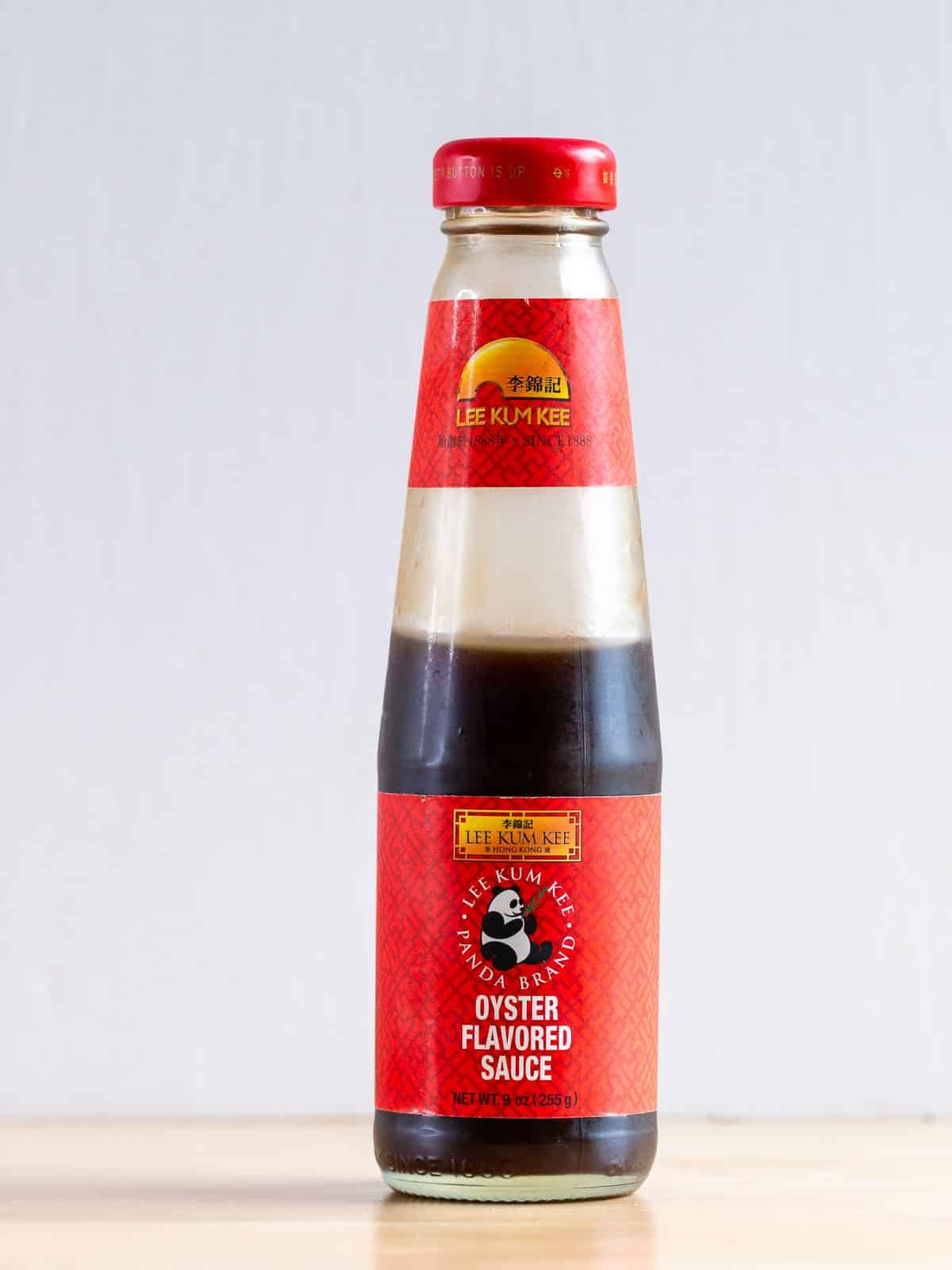
13. Oyster Sauce
If you are looking for “The Magical Sauce” that can take any dish to the next level, it is oyster sauce. The flavor is deep, savory, rich, slightly sweet, and funky at all the same time. Oyster sauce is the star ingredient in our Chinese Eggplant with Garlic sauce and plays a supporting role in recipes like beef noodles with spicy XO sauce.
There are a couple of different types of oyster sauce there is the standard oyster flavored sauce, premium, vegetarian made from mushrooms and gluten free options. You can usually find the standard oyster flavored sauce in the regular grocery store down the international isle. However, you may have to go online or to an Asian market to obtain the other selections.
If you are looking for a vegetarian option without any MSG, we have used the Wan Ja Shan vegetarian mushroom oyster sauce (available on Amazon) for guests that have a shellfish allergy, and it was quite nice.
How to Store Oyster Sauce: Once opened, store oyster sauce in the refrigerator. Follow the expiration date on the bottle to determine when it is time for a new bottle.
Nice to Have Kitchen Staples for Asian Cooking
These Asian kitchen pantry staples are nice to have because these ingredients are used by many different East Asian cuisines.
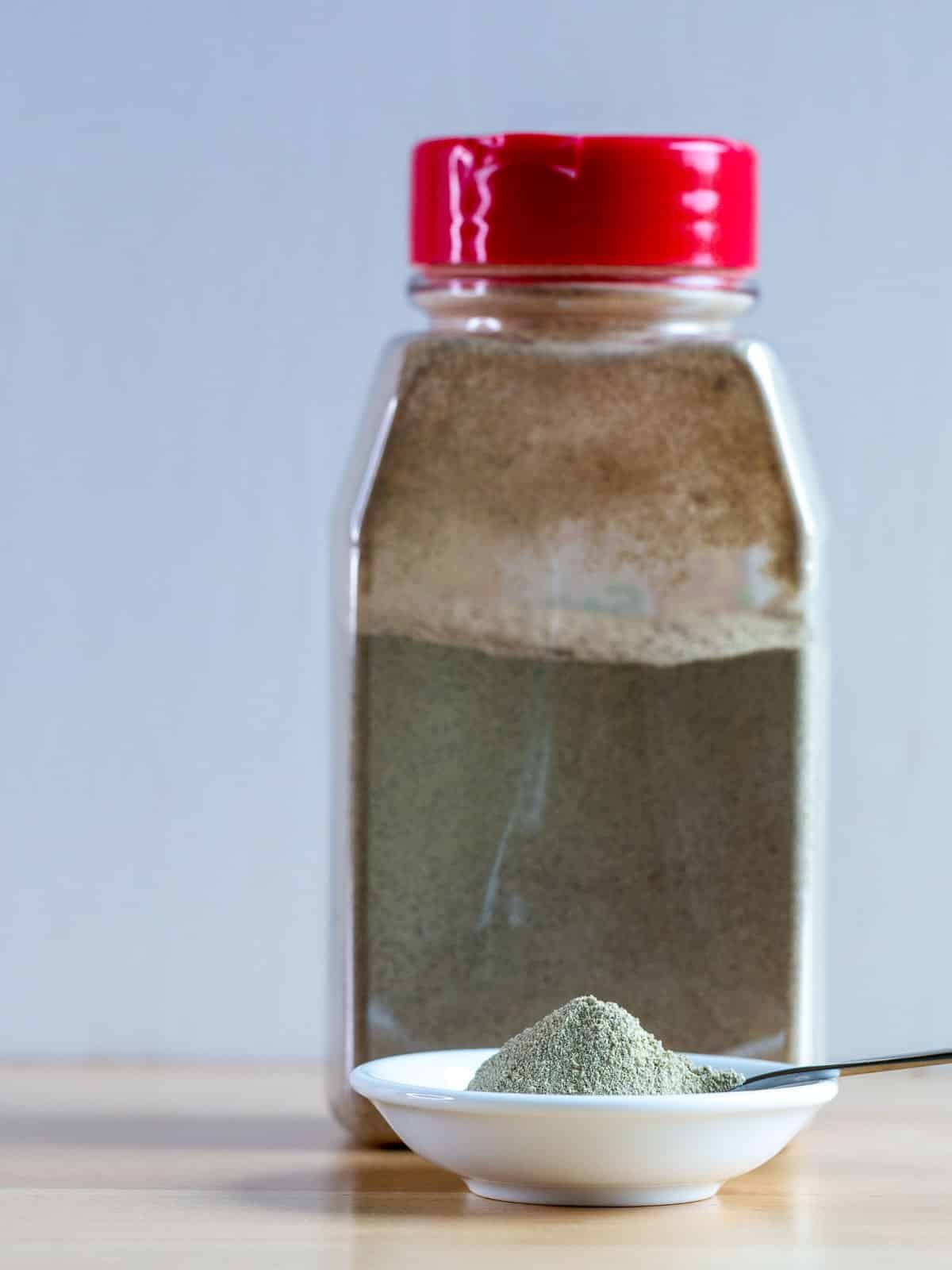
1. White Pepper
The food energy of ground white pepper is a warming-hot food according to Traditional Chinese Medicine (TCM). White pepper compared to black pepper is spicy but with additional floral notes and has an earthy flavor. It’s a delicious addition to any Asian pantry. Enjoy recipes like hot and sour soup, stir fries and literally anything that needs a little pop of heat. You can find white pepper in the regular grocery store down the spice isle. Of course, you can substitute with black pepper, but white pepper is more traditional.
How to Store White Pepper: Please store away from direct sunlight, heat and moisture and it should last you a few year.
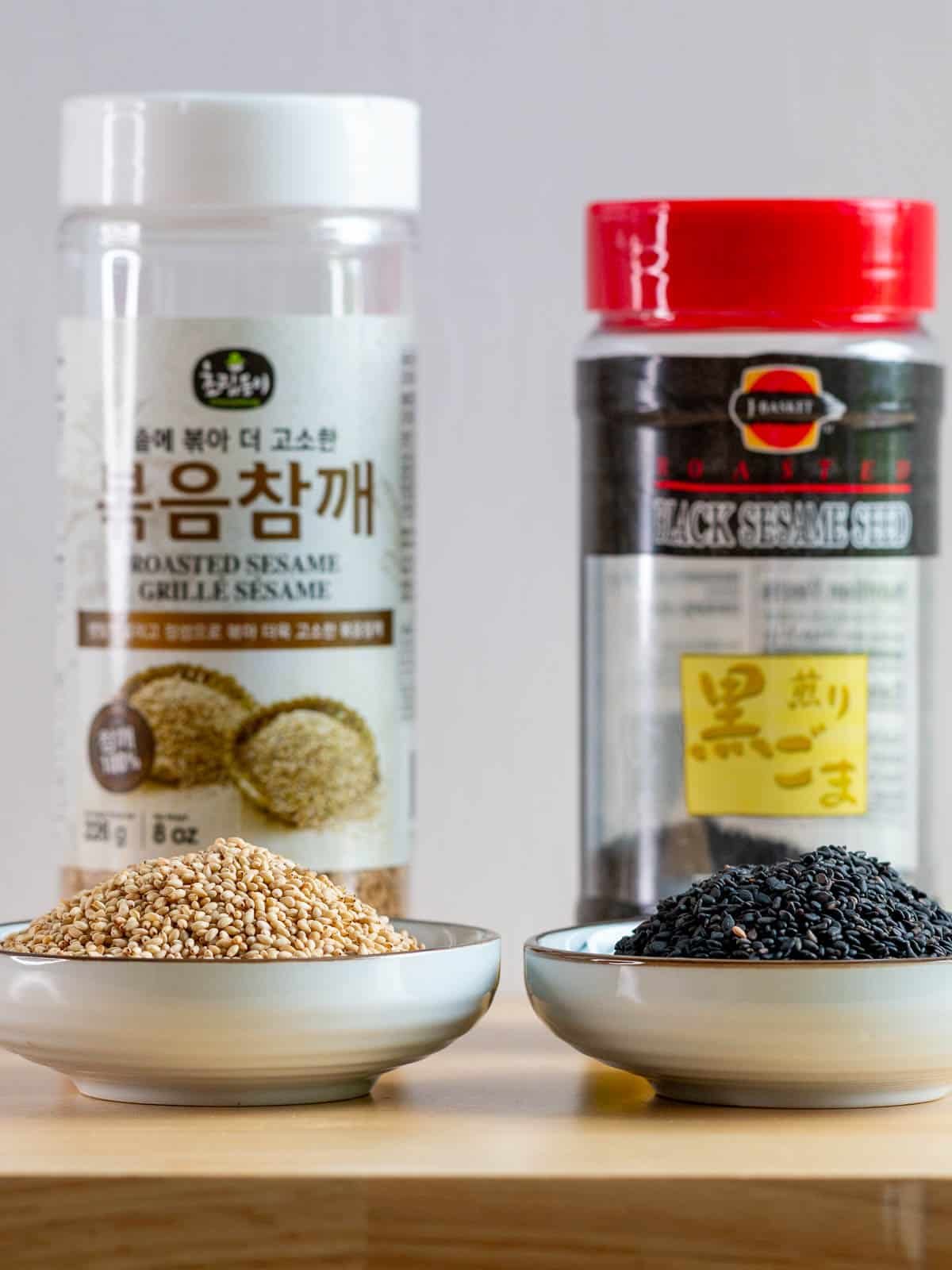
2. Sesame Seeds
We are just smitten about toasted sesame seeds and their delicious nutty flavor and aroma. If you are heavy into Japanese or Korean cuisine, you are going to want to keep either black or white sesame seeds in your pantry. Whether we are whipping up a batch of black sesame nice cream or sprinkling a few toasted sesame seeds over our garlicky stir fried green beans, having sesame seeds in stock is a very good thing.
How to Store Sesame Seeds: Once opened they can be stored in a sealed container in a cool, dry place out of direct sunlight for 3 to 4 months. However, they last longer in the refrigerator for up to 6 months and in the freezer up to 2 years. Sesame seeds can go rancid, especially if unroasted. If they taste bitter or smell odd, throw them out.
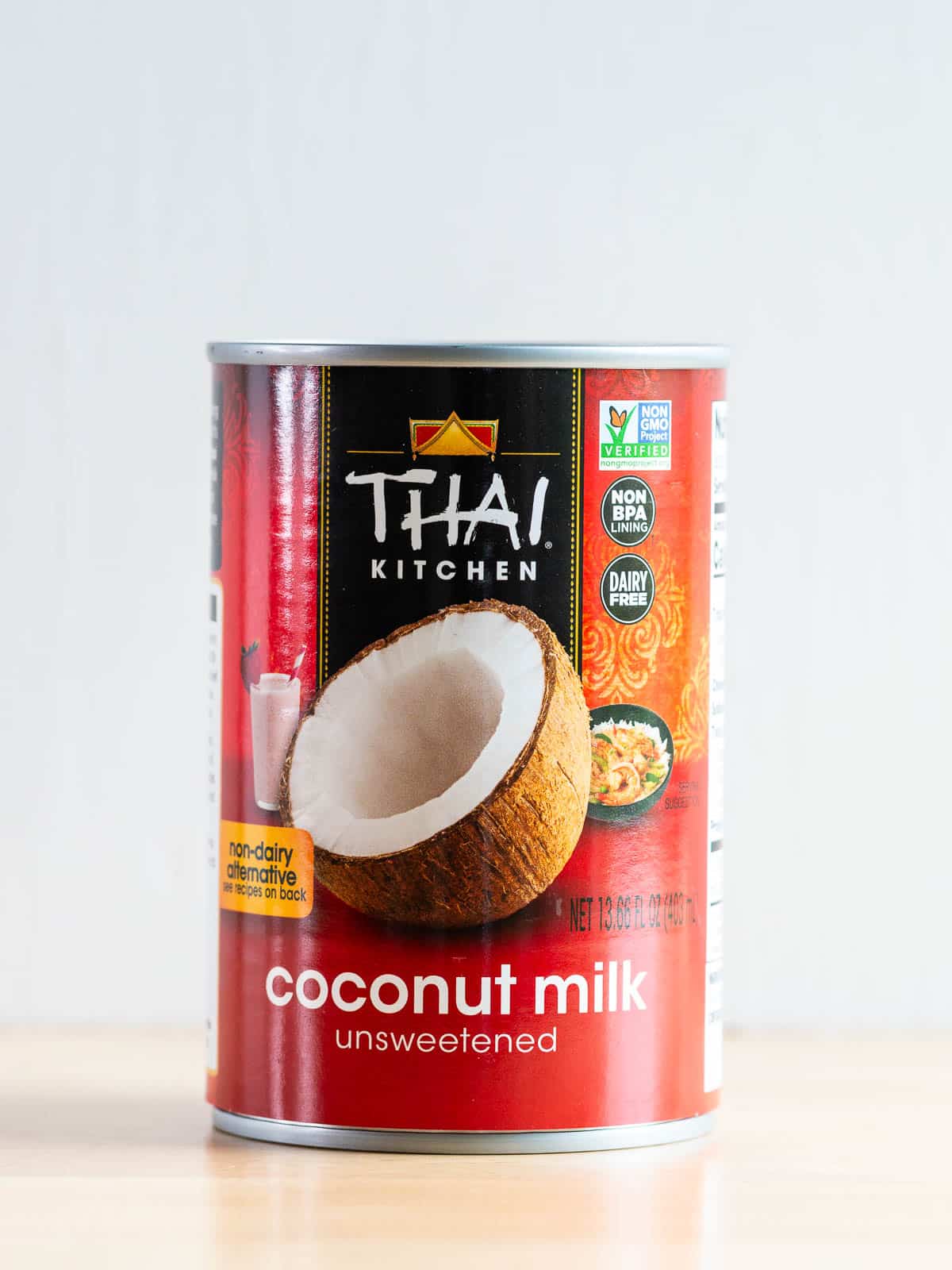
3. Coconut Milk
Raise your hand if you are a curry lover! They warm you up from the inside out. Rich dairy free coconut curries like halibut coconut curry or Thai pumpkin curry are a must try on a cold blustery day. Regular unsweetened canned coconut milk with just two ingredients coconut and water work best for curries.
Our favorite brand is Arroy-D. Sometimes, it is difficult to find unless you are shopping at an Asian grocery store. We can usually find unsweetened Thai Kitchen brand coconut milk in the regular grocery store either down the baking isle or international isle. Light canned versions and off brand coconut milks with lots of extra ingredients will not work well to crack a curry but can be used in a coconut iced chai tea latte.
How to Store Canned Coconut Milk: Unopened canned coconut milk can last between 2 to 5 years on the shelf. After opened, please transfer any unused coconut milk to a sealed container and place in the refrigerator and use within a week or place in your morning berry smoothie.
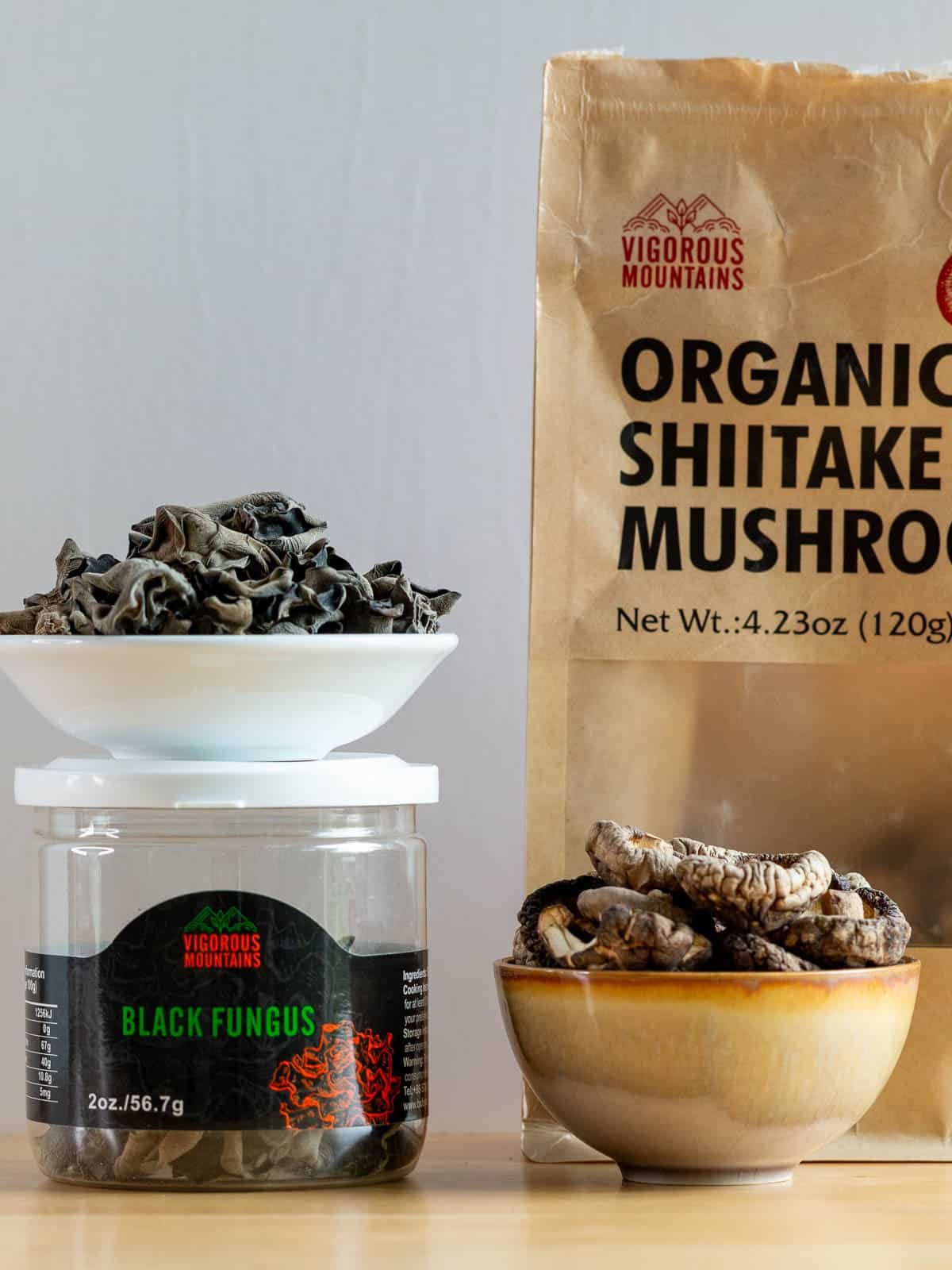
4. Dried Mushrooms
Bring on the “Shrooms”! Even if all you have in your kitchen is rice and dried mushroom, you can make something amazing with just a couple of other pantry ingredients. One of our favorite is dried shiitake mushrooms.
They have a deep woodsy earthy flavor even more intense than that of fresh mushrooms. Try a few in soups, stir fries, rice paper dumplings, vegan radish cakes and more. If you like a crunchy mushroom for salads or stir fry be sure to check out our post on how to prepare wood ear mushrooms.
Dried mushrooms, especially wood ear mushrooms, you will probably have to purchase at an Asian grocery store or online.
How to Store Dried Mushrooms: Once opened please store in a sealed container away from moisture, heat, and light. Dried mushrooms, such a wood ear mushrooms, should not be soaked for longer than 2 hours. Only reconstitute enough for the dish you are preparing and use them the same day. The reason is that the soaking of mushrooms can cause the proliferation of bacteria and you may get sick. It is best to be safe than sorry.
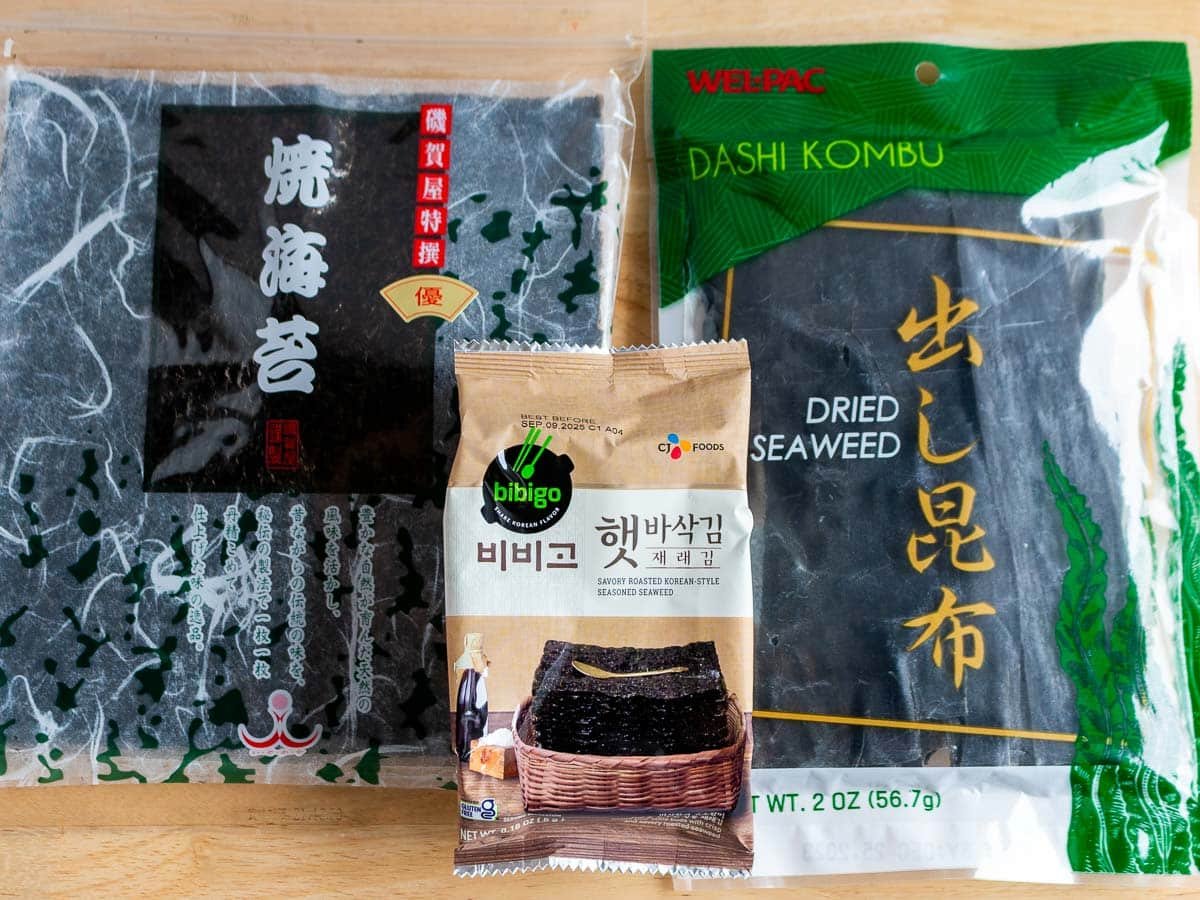
5. Nori – Gim – Laver - Dried Seaweed
Are you rolling your eyes at the thought of eating seaweed? We think it tastes a little savory, slightly sweet and a bit like the sea. It’s packed with umami flavors, vitamins, minerals, and fiber. If your kitchen is Japanese and Korean forward, you are going to want to stock up.
You may want to purchase dried nori sheets for sushi rolls, roasted seaweed snacks for scooping up baked sushi or kombu for soups. In Japan they refer to seaweed as “nori”. In Korea they call it “Gim” and in the UK, they call it laver. Seaweed is dark green (almost black) and comes in many different forms depending on what you are using it for. The nori sheets used for rolls are around 7 inches x 8 inches with indents so that it can be cut to size. The darker the sheets the better the grade of nori.
Before living in Japan, we were pretty indifferent to nori (seaweed) but that is before enjoying delicious onigiri, isobeyaki mochi or seaweed sprinkles on our rice. Now, we are hooked.
How to Store Dried Seaweed: Store seaweed in a cool, dark, and dry place inside a sealed container or plastic sealed baggie. Do not place in the refrigerator or freezer as if it gets moist it will get soggy. Many come with the little desiccant packages inside to prevent moisture.
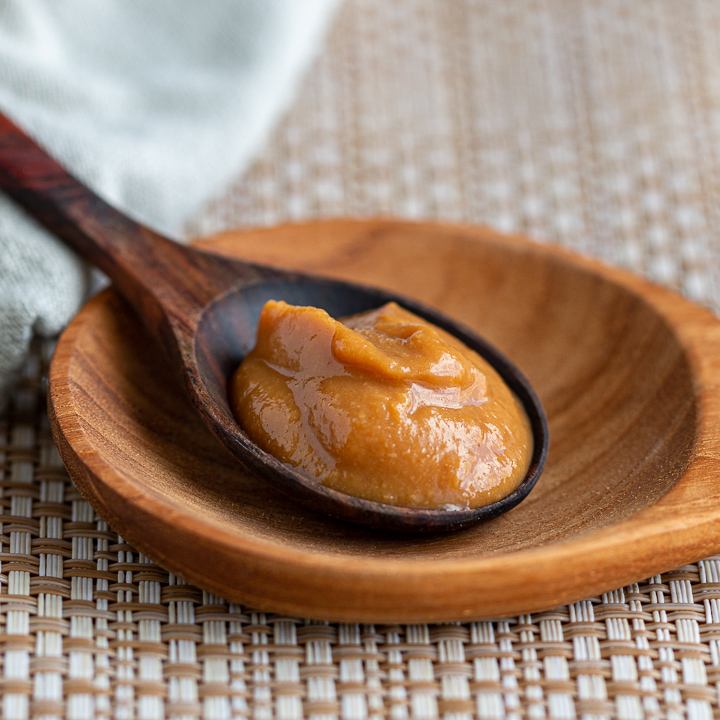
6. Miso Paste
Have you ever tried miso soup? Miso paste gives the soup it’s rich umami flavor. The paste is savory, sweet and funky from the fermentation process of soybeans, salt and koji. There are four main types of miso paste: white, yellow, red, and mixed.
Miso is delicious in marinades, as pop of flavor in sesame chicken meatballs, sauces, stews, dressings, stir fries, with ramen or even as miso butter. We used yellow miso paste to top our four ingredient baked miso salmon.
How to Store Dried Miso Paste: Store it in the refrigerator to slow down the fermentation process in a sealed container. Refer to the best as date for expiration.
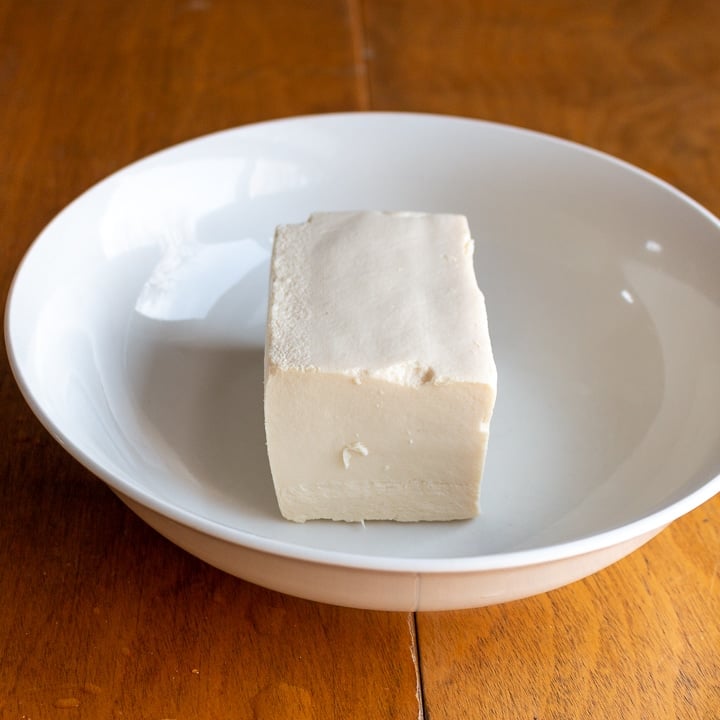
7. Tofu
Kickup the protein level in your meals with the versatile pantry staple – Tofu. This kitchen ingredient is made from soybeans. One of our favorite foodie excursions is to go to the Kung Wo Beancurd Factory in Sham Sui Po, Hong Kong. Be sure to try the tofu pudding (dou fu faa) or a bowl of fresh warm tofu right from the pot.
As most of you won’t have the option of going to the wet market, the next best option for purchasing tofu is right in the refrigerated section of a regular grocery store. There are 3 standard tofu options in a US market: soft, firm, and extra firm. The come in blocks and surrounded by a solution to keep it fresh. We use firm tofu in our savory vegetable pancakes, shrimp stuffed tofu soup, and mapo tofu.
How to Store Tofu: Store tofu in the refrigerator and use the expiration date on the package. To keep leftover tofu fresh, cover the tofu block with fresh water. Place the leftover tofu in the refrigerator in a covered container and use within 2 to 3 days.
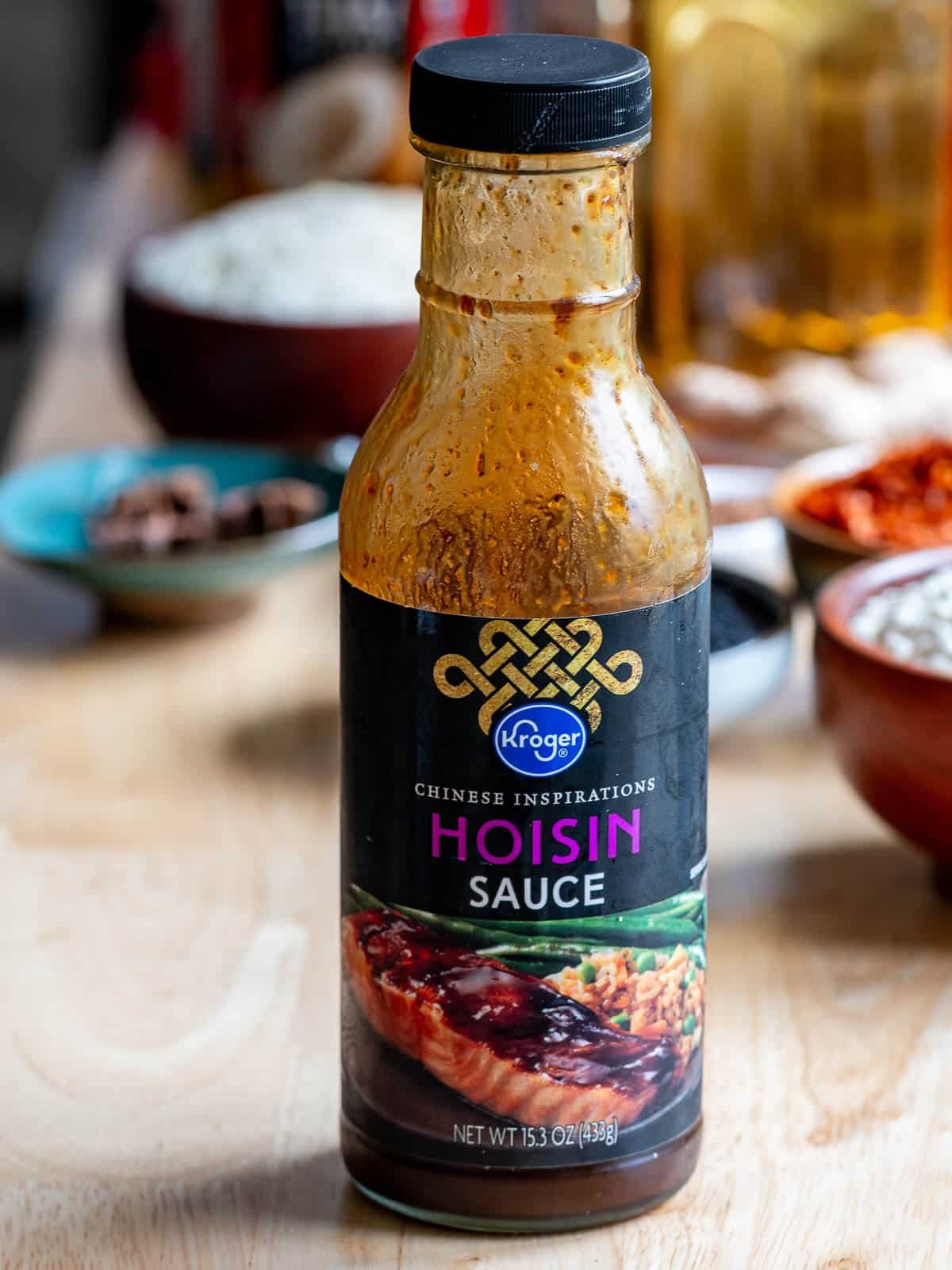
8. Hoisin Sauce
Last but not least we have sweet and savory sauce that is used a lot in American-Chinese recipes. Made with fermented soybeans, five spice powder, sesame seeds, sugar and more. This one ingredient adds loads of flavors to stir fry recipes.
Try our recipe for Peking beer butt chicken recipe this summer with that sweet sticky sauce that turns dining into a finger licking good experience. Hoisin sauce is usually available in the International section of your regular grocery store.
How to Store Hoisin Sauce: After opening, be sure to store it in the refrigerator where it can generally last 3 to 6 months.
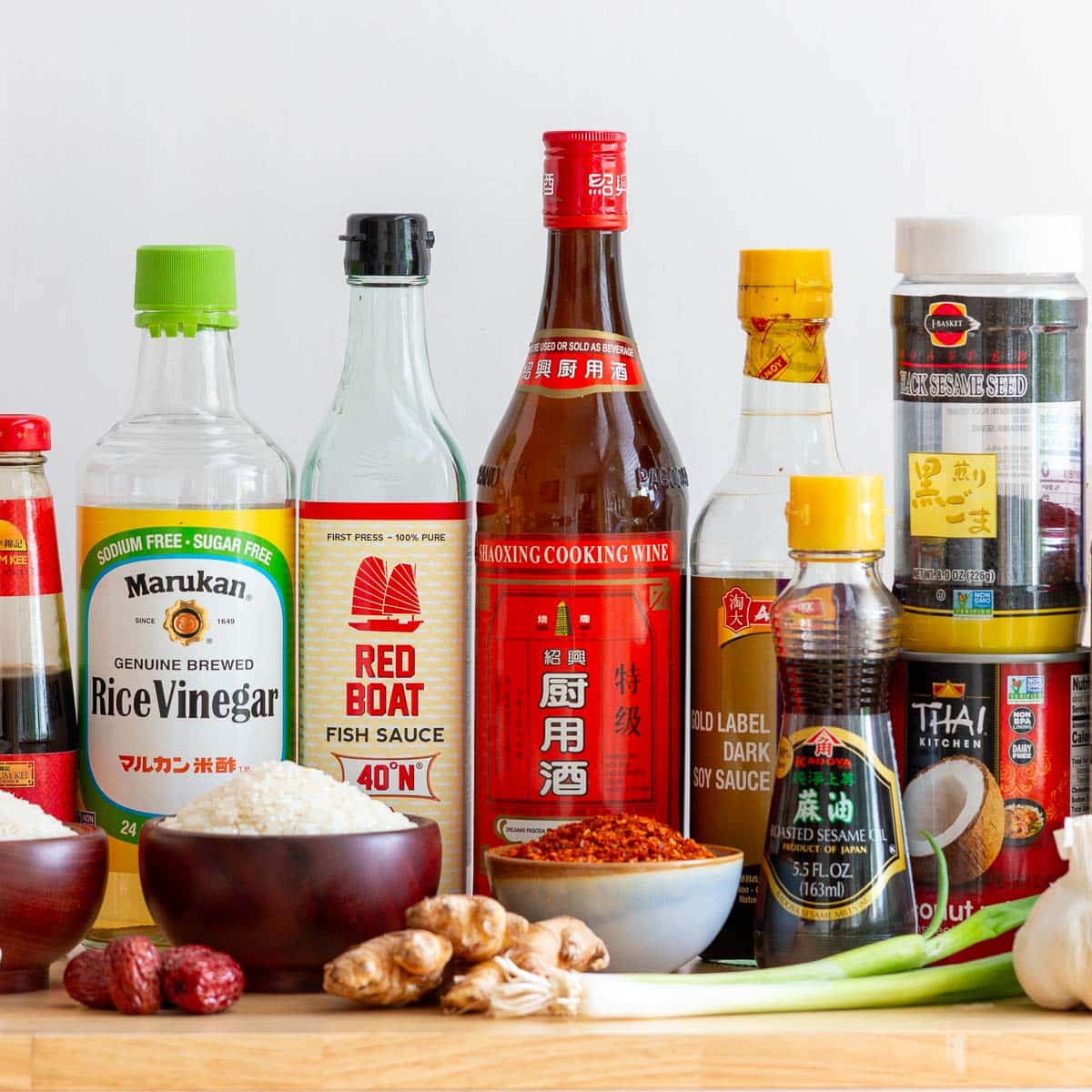
Time to Stock Up!
You can make hundreds of delicious Asian dishes with these Asian kitchen food staples. Many of these can be found at your local grocery store. Other specialty items can be found online. Have you ever tried the online Asian supermarket, Weee? They have a nice selection of fresh and shelf staple items that can be delivered to you. It’s time to stock up so you are ready to make some healthy quick and easy Asian recipes.
Did You Like Our Recipe? Leave a ⭐⭐⭐⭐⭐ rating and/or a review in the comments section below. Your feedback is always appreciated! Follow us for more delicious recipes on Pinterest, Instagram, Twitter and Facebook! Don't forget to sign up for our email list for more free recipes.
East Asian Recipes
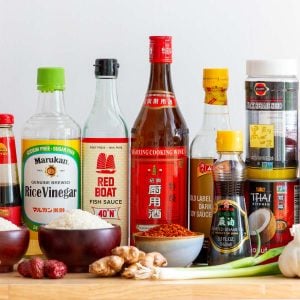
Essential Asian Pantry Staples: Your Guide to Cooking
Ingredients
13 Essential Asian Pantry Staples
- rice (Choose Thai jasmine, Japanese sushi rice, long grained rice or glutinous rice)
- noodles (Choose rice noodles, lo mein, soba, udon, rice vermicelli, glass noodles or even angel hair pasta)
- soy sauce (Choose traditional light soy sauce for everyday cooking. If you do a lot of Asian cooking add dark soy sauce and/or sweet soy sauce. Gluten free options include coconut amino and tamari)
- fish sauce (any brand but we like Fish Boat for a gluten free option.)
- roasted sesame oil (premium is best)
- cooking wine (Shaoxing wine for Chinese cooking. Mirin or Ashi Mirin for Japanese or Korean cooking. Substitute Asian cooking wines with cooking sherry. )
- rice vinegar (plain)
- neutral oil (Your choice - options like avocado oil or other with a high smoke point.)
- aromatics (fresh garlic, green onions and ginger.)
- chili garlic sauce (or sriracha sauce)
- sweetener (honey, jujubes (Chinese red dates), brown sugar or sugar alternative of choice)
- cornstarch (or potato starch)
- oyster sauce (Your choice oyster flavored sauce, premium, vegetarian made from mushrooms and gluten free brands)
8 Nice to Have Pantry Ingredients
- white pepper
- roasted sesame seeds (white or black)
- coconut milk (canned unsweetened. We like Arroy-D or choose an option that has the least amount of additives.)
- dried mushrooms (shiitake or wood ear mushrooms)
- dried seaweed (also called Nori, Gam, Laver sheets for sushi rolls, roasted seaweed snacks or kombu for soups)
- miso paste (light for soups, medium, red or mixed. See post above for types and uses.)
- tofu (soft, firm or extra firm. We use firm for most of our recipes.)
Instructions
- See in post for 56 unique recipes using these essential Asian Pantry staples.


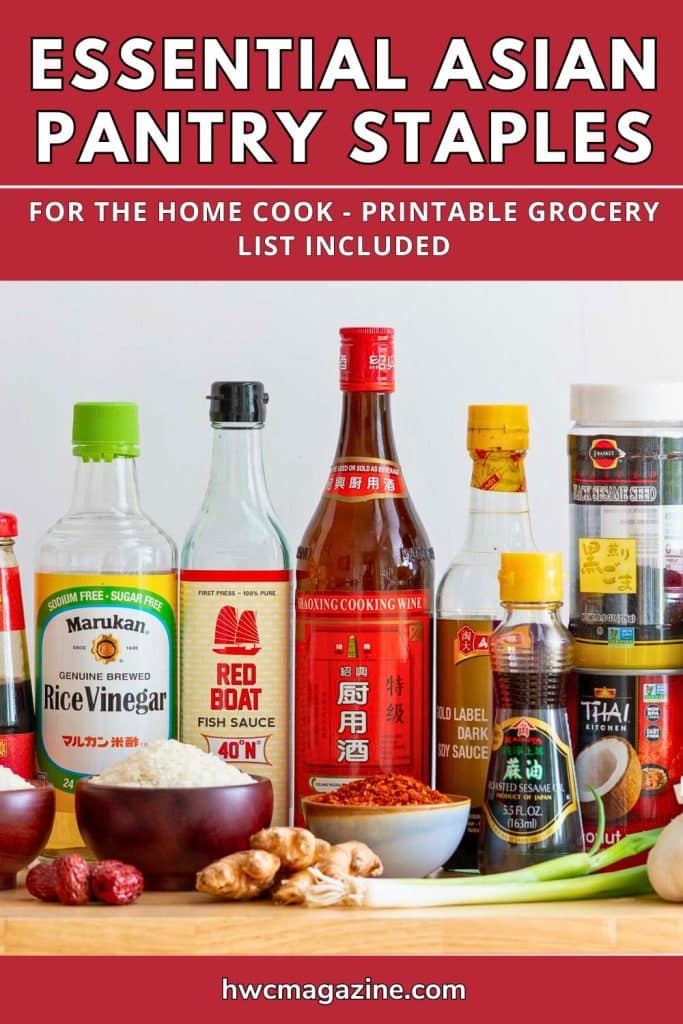
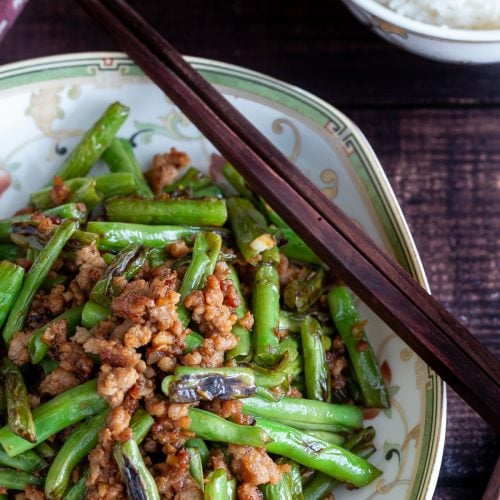
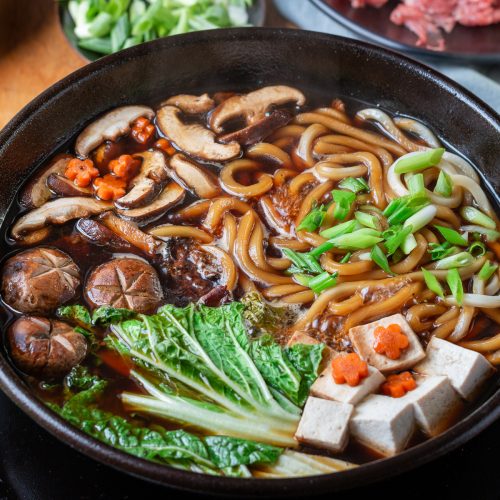
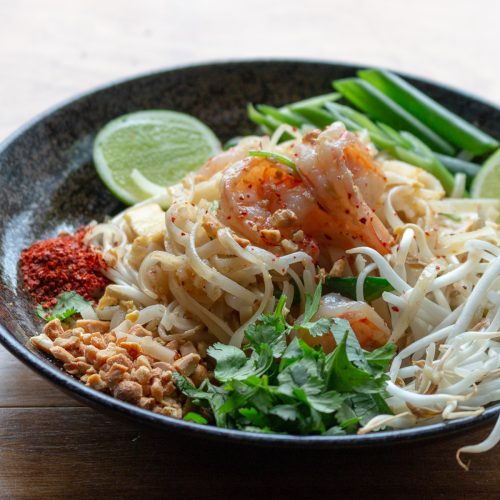
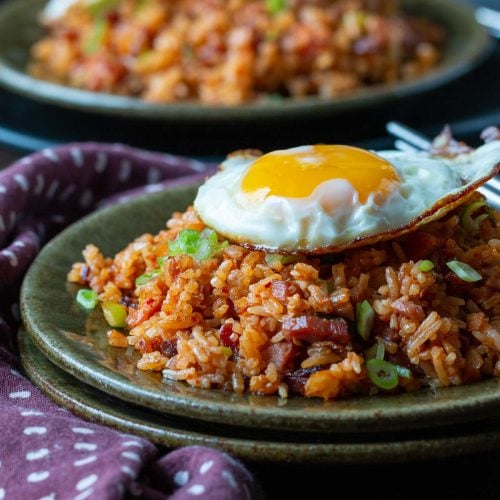
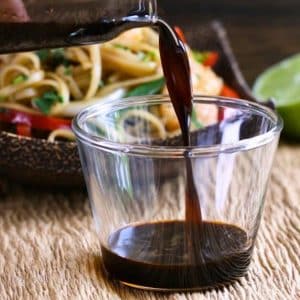
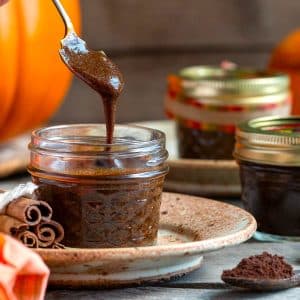

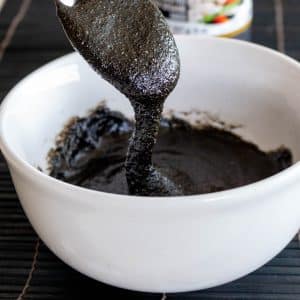

Michelle says
Such a great round up of pantry essentials! So many ingredients that I use in my own kitchen as well 🙂
HWC Magazine says
Thank you Michelle, we both have so many Asian ingredients in our pantry. The difficult part was downsizing the list to just the essentials.😂 Take Care
Hannah says
This is such a thoughtful, thorough list! Truly an excellent resource for anyone heading to the Asian market or stocking a kitchen for success. Thank you for all the work you put into this!
HWC Magazine says
Thank you so much. So glad you found this Asian staple kitchen resource helpful. If you have any questions while shopping for any supplies, we are here to help. Take care
Heidi says
Thank you so much for putting this together, I absolutely love this comprehensive guide! No need to guess on how to properly store my favorite Asian food ingredients, I can just take a quick glance at your comprehensive list and know exactly what to do! Perfect!!
HWC Magazine says
Thank you Heidi! Delighted to hear that this ultimate guide to stocking up and storing your Asian pantry was helpful. Wishing you a super week ahead.
Raul says
This is so helpful. Delighted to know more about essential pantry ingredients and that many I can find right at the regular grocery store.
HWC Magazine says
Thanks so much Raul. I know you had been requesting to know what Asian sauces, spices and such we use on an everyday basis. So glad you found this helpful. Once you have your supplies, be sure to try an easy pork and shiitake mushroom stir fry. Take Care